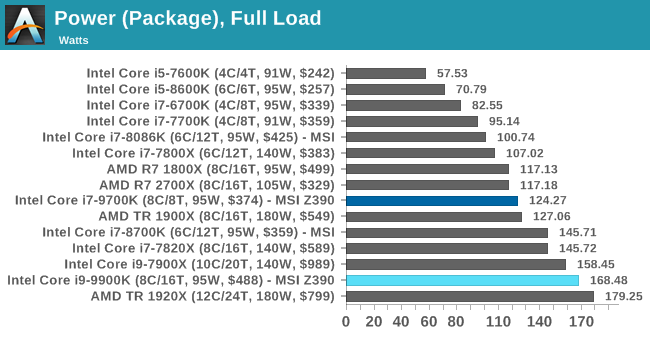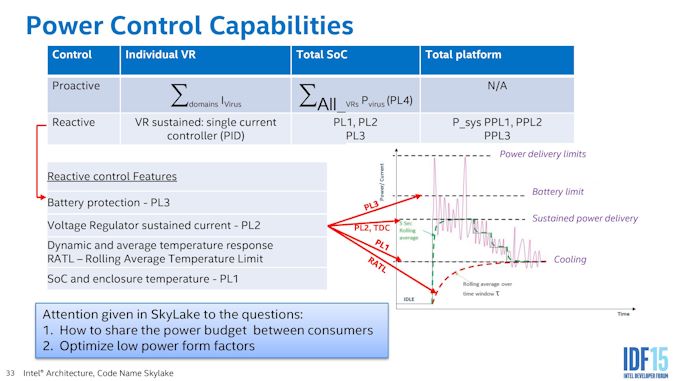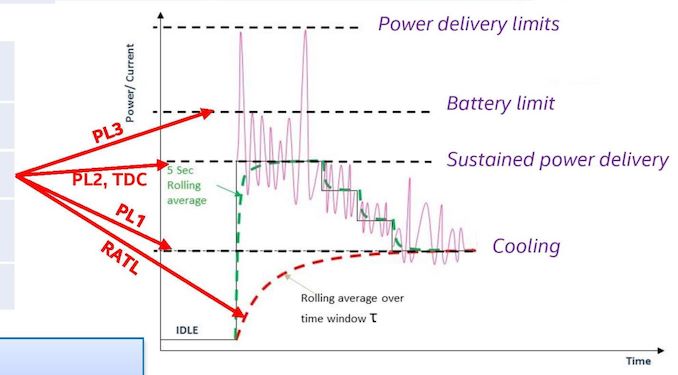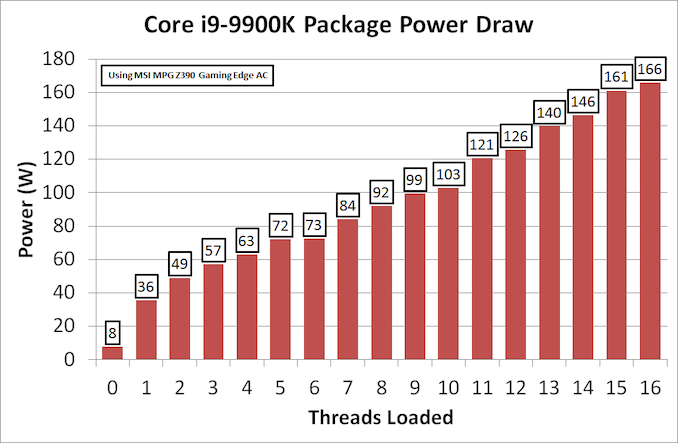The Intel 9th Gen Review: Core i9-9900K, Core i7-9700K and Core i5-9600K Tested
by Ian Cutress on October 19, 2018 9:00 AM EST- Posted in
- CPUs
- Intel
- Coffee Lake
- 14++
- Core 9th Gen
- Core-S
- i9-9900K
- i7-9700K
- i5-9600K
Power Consumption
TDP or not the TDP, That is The Question
Notice: When we initially posted this page, we ran numbers with an ASRock Z370 board. We have since discovered that the voltage applied by the board was super high, beyond normal expectations. We have since re-run the numbers using the MSI MPG Z390 Gaming Edge AC motherboard, which does not have this issue.
As shown above, Intel has given each of these processors a Thermal Design Power of 95 Watts. This magic value, as mainstream processors have grown in the last two years, has been at the center of a number of irate users.
By Intel’s own definitions, the TDP is an indicator of the cooling performance required for a processor to maintain its base frequency. In this case, if a user can only cool 95W, they can expect to realistically get only 3.6 GHz on a shiny new Core i9-9900K. That magic TDP value does not take into account any turbo values, even if the all-core turbo (such as 4.7 GHz in this case) is way above that 95W rating.
In order to make sense of this, Intel uses a series of variables called Power Levels: PL1, PL2, and PL3.
That slide is a bit dense, so we should focus on the graph on the right. This is a graph of power against time.
Here we have four horizontal lines from bottom to top: cooling limit (PL1), sustained power delivery (PL2), battery limit (PL3), and power delivery limit.
The bottom line, the cooling limit, is effectively the TDP value. Here the power (and frequency) is limited by the cooling at hand. It is the lowest sustainable frequency for the cooling, so for the most part TDP = PL1. This is our ‘95W’ value.
The PL2 value, or sustained power delivery, is what amounts to the turbo. This is the maximum sustainable power that the processor can take until we start to hit thermal issues. When a chip goes into a turbo mode, sometimes briefly, this is the part that is relied upon. The value of PL2 can be set by the system manufacturer, however Intel has its own recommended PL2 values.
In this case, for the new 9th Generation Core processors, Intel has set the PL2 value to 210W. This is essentially the power required to hit the peak turbo on all cores, such as 4.7 GHz on the eight-core Core i9-9900K. So users can completely forget the 95W TDP when it comes to cooling. If a user wants those peak frequencies, it’s time to invest in something capable and serious.
Luckily, we can confirm all this in our power testing.
For our testing, we use POV-Ray as our load generator then take the register values for CPU power. This software method, for most platforms, includes the power split between the cores, the DRAM, and the package power. Most users cite this method as not being fully accurate, however compared to system testing it provides a good number without losses, and it forms the basis of the power values used inside the processor for its various functions.
Starting with the easy one, maximum CPU power draw.

Focusing on the new Intel CPUs we have tested, both of them go beyond the TDP value, but do not hit PL2. At this level, the CPU is running all cores and threads at the all-core turbo frequency. Both 168.48W for the i9-9900K and 124.27W for the i7=9700K is far and above that ‘TDP’ rating noted above.
Should users be interested, in our testing at 4C/4T and 3.0 GHz, the Core i9-9900K only hit 23W power. Doubling the cores and adding another 50%+ to the frequency causes an almost 7x increase in power consumption. When Intel starts pushing those frequencies, it needs a lot of juice.
If we break out the 9900K into how much power is consumed as we load up the threads, the results look very linear.
This is as we load two threads onto one core at a time. The processor slowly adds power to the cores when threads are assigned.
Comparing to the other two ‘95W’ processors, we can see that the Core i9-9900K pushes more power as more cores are loaded. Despite Intel officially giving all three the same TDP at 95W, and the same PL2 at 210W, there are clear differences due to the fixed turbo tables embedded in each BIOS.
So is TDP Pointless? Yes, But There is a Solution
If you believe that TDP is the peak power draw of the processor under default scenarios, then yes, TDP is pointless, and technically it has been for generations. However under the miasma of a decade of quad core processors, most parts didn’t even reach the TDP rating even under full load – it wasn’t until we started getting higher core count parts, at the same or higher frequency, where it started becoming an issue.
But fear not, there is a solution. Or at least I want to offer one to both Intel and AMD, to see if they will take me up on the offer. The solution here is to offer two TDP ratings: a TDP and a TDP-Peak. In Intel lingo, this is PL1 and PL2, but basically the TDP-Peak takes into account the ‘all-core’ turbo. It doesn’t have to be covered under warranty (because as of right now, turbo is not), but it should be an indication for the nature of the cooling that a user needs to purchase if they want the best performance. Otherwise it’s a case of fumbling in the dark.














274 Comments
View All Comments
Ian Cutress - Monday, October 22, 2018 - link
Emn13: Base code with compiler optimizations only, such as those a non-CompSci scientist would use, as was the original intention of the 3DPM test, vs hand tuned AVX/AVX2/AVX512 code.just4U - Saturday, October 20, 2018 - link
The only problem I really have with the product is for the price it should have come with a nice fancy cooler like the 2700x which is in it's own right a stellar product at close to 60% of the cost. Not sure what intel's game plan is with this but It's priced close to a second gen entry threadripper and for it's cost you might as well just make the leap for a little more.khanikun - Monday, October 22, 2018 - link
I'm the other way. I'd much rather they lower the cost and have no cooler. Although, Intel doesn't decrease the cost without the cooler, which sucks.I'm either getting a new waterblock or drilling holes in the waterblock bracket to make it fit. Well I just upgraded, so I'm not in the market for any of these procs.
brunis.dk - Saturday, October 20, 2018 - link
no prayers for AMD?ingwe - Friday, October 19, 2018 - link
I don't see the value in it though I understand that this isn't sold as a value proposition--it is sold for performance. Seems to do the job it sets out to do but isn't spectacularly exciting to me.jospoortvliet - Saturday, October 20, 2018 - link
Given how the quoted prices ignore the fact that right now Intel CPU prices art 30-50% higher than MSRP, yes, nobody thinking about value for money buys these...DanNeely - Friday, October 19, 2018 - link
Seriously though, I'm wondering about the handful of benchmarks that showed the i7 beating the i9 by significant amounts. 1-2% I assume is sampling noise in cases where the two are tied, but flipping through the article I saw a few where the i7 won by significant margins.Ian Cutress - Friday, October 19, 2018 - link
Certain benchmarks seem to be core-resource bound. In HT mode, certain elements of the core are statically partitioned, giving each thread half, and if only one thread is there, you still only get half. With no HT, a thread gets the full core to work with.0ldman79 - Friday, October 19, 2018 - link
I'd love to see some low level data on the i5 vs i7 on that topic.If the i5 is only missing HT then the i7 without HT should score identically (more or less) with the i5 winning on occasion vs the HT enabled i7. I always figured there was a significant bit of idle resources (ALU pipelines) in the i5 vs the i7, HT allowed 100% (or as close as possible) usage of all of the pipelines.
I wish Intel would release detailed info on that.
abufrejoval - Friday, October 19, 2018 - link
Well I guess you should be able to measure, if you have the chips. My understanding has alway been, that i7/i5 differentiation is all about voltage levels with i5 parts needing too much voltage/power to pass the TDP restrictions rather than defective logic precluding the use of 'one hyperthread'. I find it hard to imagine managing defects via partitions in the register file or by disabling certain ALUs: If core CPU logic is hit with a defect it's dead, because you can't isolate and route around the defective part at that granularity. It's the voltage levels on the long wires that determine a CPUs fate AFAIK.It's a free choice between a lower clock and HT or the higher clock without HT at the binning point and Intel will determine the fate of a chips on sales opportunities rather than hardware. And it's somewhat similar with the fully enabled lower power -T parts and the high-frequency -K parts, which are most likely the same (or very similar) top tier bins, sold at two distinct voltage levels yet rather similar premium prices, because you trade power and clocks and pay premium for efficiency.
Real chips defects can only be 'compensated' via cutting off cache blocks or whole cores, but again I'd tend to think that even that will be more driven by voltage considerations than 'hairs in the soup': With all this multi-patterning and multi-masking going on and the 3D structures they are lovingly creating for every FinFeT their control over the basic structures is so great, that it's mainly the layer alignment/conductivity that's challenging the yields.